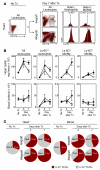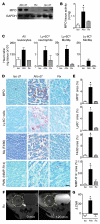Myeloperoxidase-rich Ly-6C+ myeloid cells infiltrate allografts and contribute to an imaging signature of organ rejection in mice
- PMID: 20577051
- PMCID: PMC2898607
- DOI: 10.1172/JCI42304
Myeloperoxidase-rich Ly-6C+ myeloid cells infiltrate allografts and contribute to an imaging signature of organ rejection in mice
Abstract
Rates of graft rejection are high among recipients of heart transplants. The onset and progression of clinically significant heart transplant rejection are currently monitored by serial biopsy, but this approach is highly invasive and lacks sensitivity. Here, we have developed what we believe to be a new technique to measure organ rejection noninvasively that involves the exploration of tissue-infiltrating leukocytes as biomarker sources for diagnostic imaging. Specifically, we profiled the myeloid response in a murine model of heart transplantation with the aim of defining and validating an imaging signature of graft rejection. Ly-6Chi monocytes, which promote inflammation, accumulated progressively in allografts but only transiently in isografts. Ly-6Clo monocytes, which help resolve inflammation, did not accumulate, although they composed the majority of the few remaining monocytes in isografts. The persistence of Ly-6Chi monocytes in allografts prompted us to screen for a Ly-6Chi monocyte-associated imaging marker. Low-density array data revealed that Ly-6Chi monocytes express 10-fold higher levels of myeloperoxidase (MPO) than Ly-6Clo monocytes. Noninvasive magnetic resonance imaging of MPO with an MPO-activatable Gd-chelate revealed a spatially defined T1-weighted signal in rejected allografts but not in isografts or MPO-deficient allograft recipients. Flow cytometry, enzymography, and histology validated the approach by mapping MPO activity to Ly-6Chi monocytes and neutrophils. Thus, MPO imaging represents a potential alternative to the current invasive clinical standard by which transplants are monitored.
Figures







References
-
- Miniati DN, Robbins RC. Heart transplantation: a thirty-year perspective. Annu Rev Med. 2002;53:189–205. - PubMed
-
- Kubo SH, et al. Risk factors for late recurrent rejection after heart transplantation: a multiinstitutional, multivariable analysis. Cardiac Transplant Research Database Group. J Heart Lung Transplant. 1995;14(3):409–418. - PubMed
-
- Tucker PA 2nd, Jin BS, Gaos CM, Radovancevic B, Frazier OH, Wilansky S. Flail tricuspid leaflet after multiple biopsies following orthotopic heart transplantation: echocardiographic and hemodynamic correlation. J Heart Lung Transplant. 1994;13(3):466–472. - PubMed
Publication types
MeSH terms
Substances
Grants and funding
- R01 HL095612/HL/NHLBI NIH HHS/United States
- U24 CA092782/CA/NCI NIH HHS/United States
- U01 HL080731/HL/NHLBI NIH HHS/United States
- R01HL095629/HL/NHLBI NIH HHS/United States
- R00 HL094533/HL/NHLBI NIH HHS/United States
- R01 NS070835/NS/NINDS NIH HHS/United States
- U01-HL080731/HL/NHLBI NIH HHS/United States
- R01 HL096576/HL/NHLBI NIH HHS/United States
- R01 HL095629/HL/NHLBI NIH HHS/United States
- K08HL081170/HL/NHLBI NIH HHS/United States
- K08 HL081170/HL/NHLBI NIH HHS/United States
- R01 NS072167/NS/NINDS NIH HHS/United States
- U24-CA092782/CA/NCI NIH HHS/United States
- R01 AI084880/AI/NIAID NIH HHS/United States
LinkOut - more resources
Full Text Sources
Other Literature Sources
Medical
Research Materials
Miscellaneous

